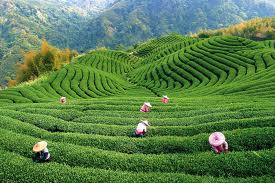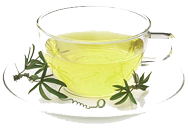 Tea plantations are grouped in two main areas: the east and west. The first is more explored by Europeans, and it focused a major production of so-called long leaf teas, moving in international trade. Here, before the cultures are grown tea leaves and the best of its kind.
Tea plantations are grouped in two main areas: the east and west. The first is more explored by Europeans, and it focused a major production of so-called long leaf teas, moving in international trade. Here, before the cultures are grown tea leaves and the best of its kind.This area, that is, the eastern group of tea plantations, is the eastern edge of the Chinese Empire, and between Nankomom Fuchefu, south of the lower reaches of the river Yantsekianga. To the east, this band is not tea comes from the sea verst 50-100, and to the west does not reach Lake Thun-Chin. In general, this area stretches across 500 miles from north to south, and 600 miles long from east to west.
Production is concentrated in six densely populated provinces in China: Fu-Kian (Fu-Chan or Fu-chien, is considered the birthplace of tea), Kian-nan, Kiang-si, Che-kiang, Kuo-nan and Gu Kuang. Of the six provinces of the main centers of tea culture are the first four, and where the best teas are grown. Plantation is occupied by a narrow geographic band, just 400 miles - 500 wide. The best varieties are grown on the southern slopes of Wu-i-shan, 200 miles in length, with those in respect of the most famous varieties of high culture - Mount Wu-and in God, a rich variety of other gifts of nature and having the same religious significance . High grade divorced James in the region in An-ching-fu on the mountain Ming-shan (this tea is called Jin-lun), of High chzheu Fu on Mount Huang-shan (mostly green tea called Sung-lo-cha ) and others.
The western group of tea plantation lies at 300 - 400 miles from the East, along the upper reaches of the Yantsekianga. In this district stretches the length of the river basin Kiang-Kian to the border of Tibet. The band dilution of tea here is somewhat broader than in the eastern region, but less scattered plantations. In this band consists of three provinces Yun-nan, Su-chuan and Kuei-Cheu, but the tea is not diluted over the place, but only in nine districts. Extreme eastern border of Tibet, is also the western limit of distribution of tea in China, which is interrupted in the town of Cha-ho-ting (ie hill with tea tree).
The area produced lower grades of tea, dramatically different from those which we know and which are produced in the eastern region. Here, the main production of tea in compressed form. In the province of Yun-nan tea bush grows to the size of these trees. Caring for them is the most primitive collected leaves are longer and thicker than the bushes east region. Tea turns rough, but cheap, very common in the population of the western provinces of China and not whimsical inhabitants of neighboring countries. 
